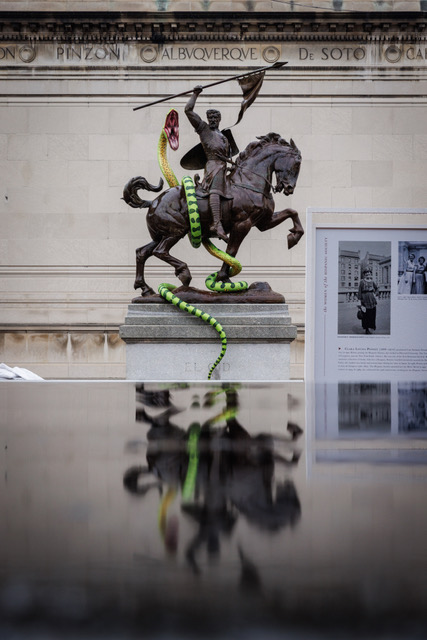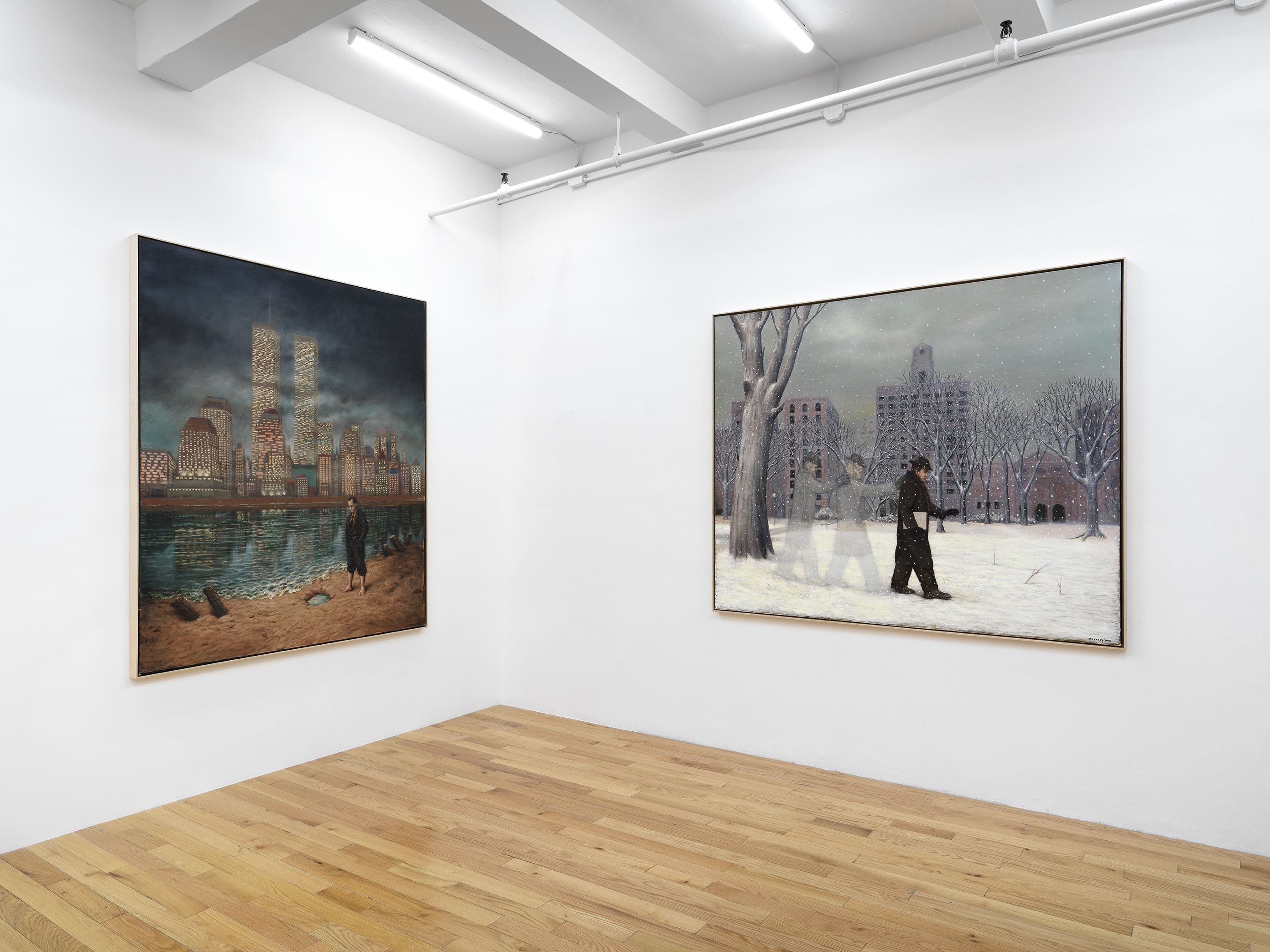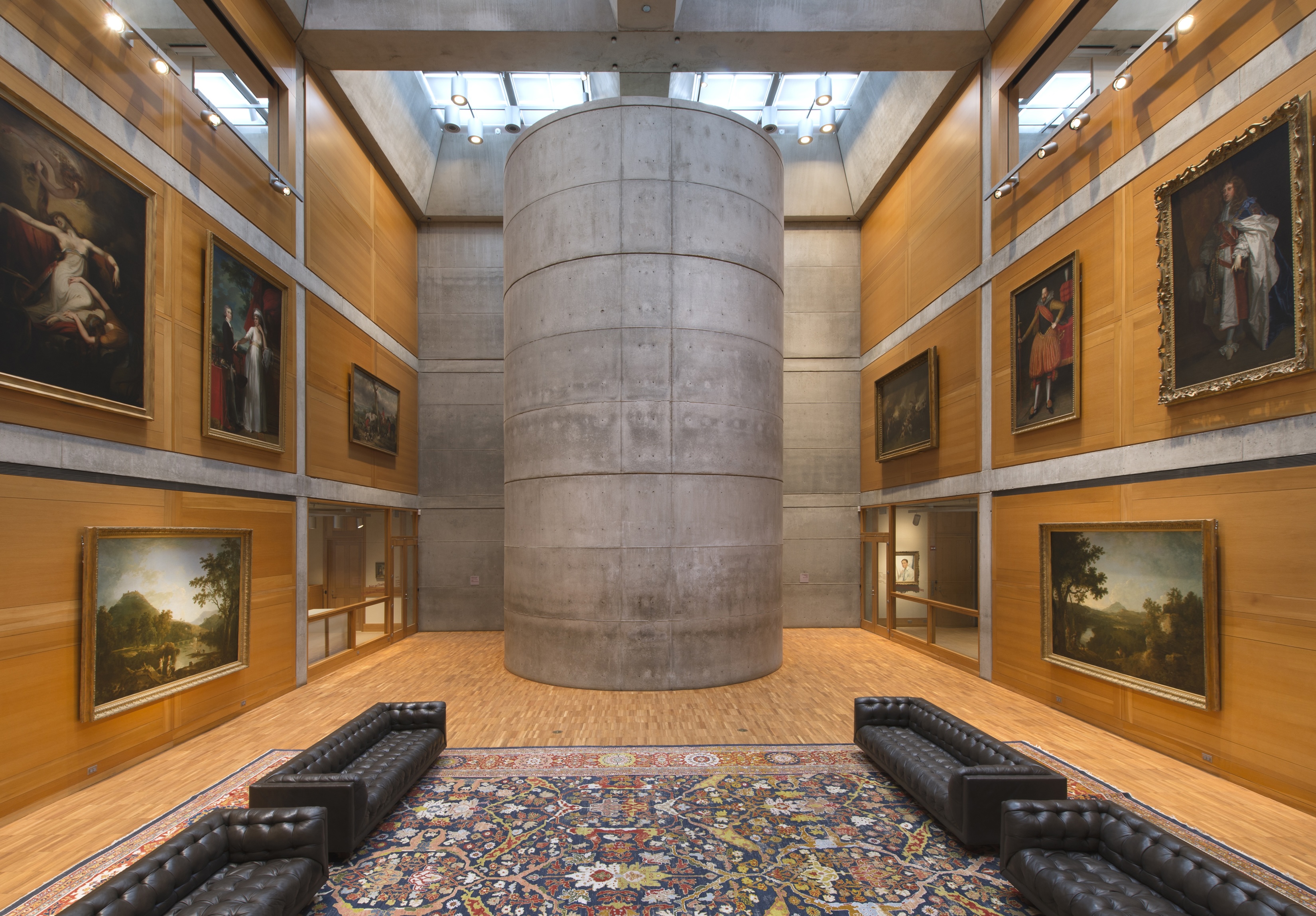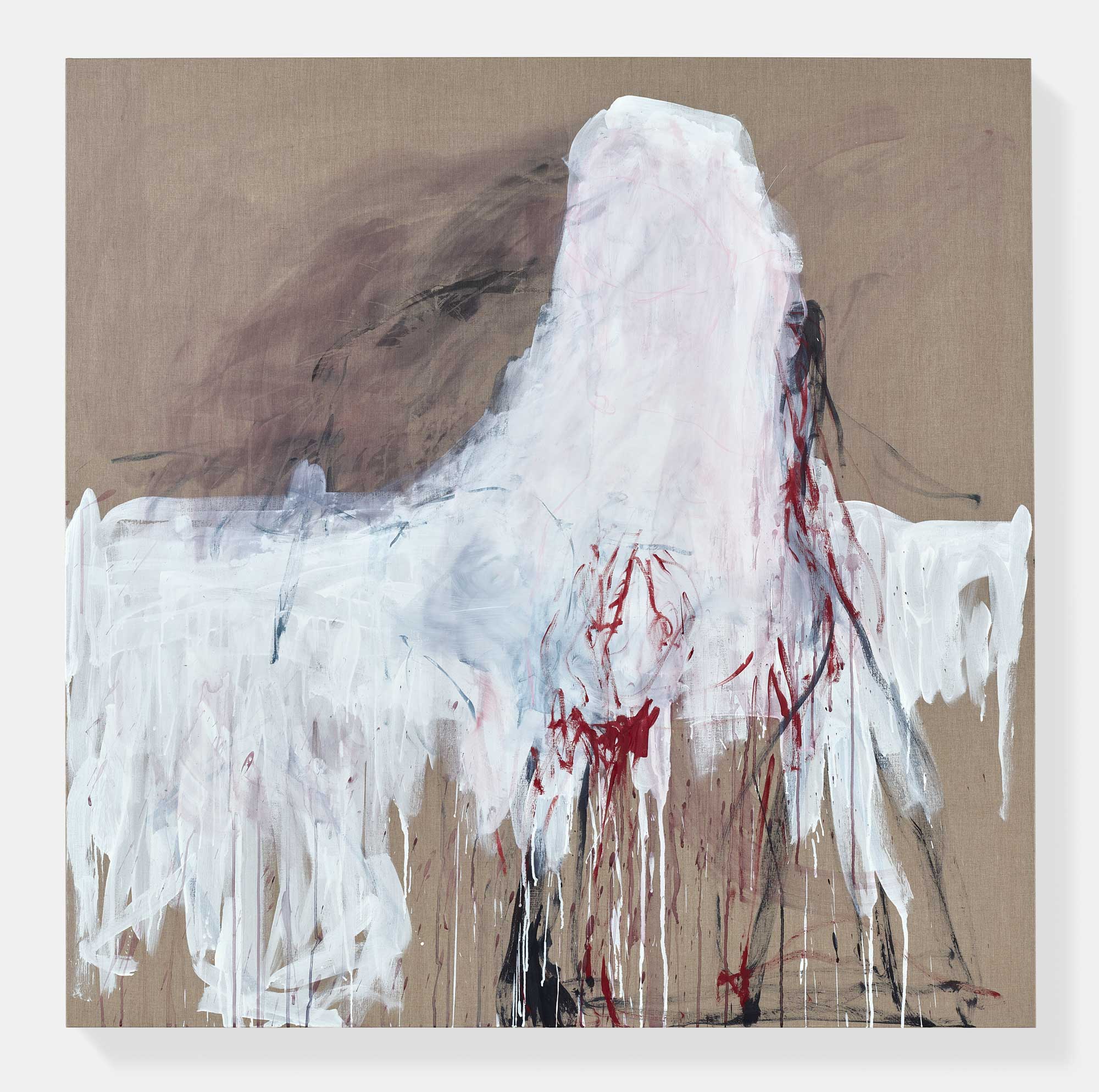Welcome back to Wall Power. I’m Marion Maneker, coming to you from Los
Angeles.
I’m here for Design.Space LA. But tonight I want to tell you about a few exhibitions that just opened in New York. The first is by Brazilian artist Adriana Varejão, who worked with the Hispanic Society to highlight aspects of their extraordinary historic collection of ceramics. The second is an exhibition at Paul Soto gallery that rediscovers the work of Roberto Márquez, an otherworldly painter. Finally, we head up to New Haven to tour Yale’s
Center for British Art, brutalist architect Louis Kahn’s masterpiece, which is reopening tomorrow after a major renovation.
But first, here’s more on what I’m doing in L.A. this weekend…
|
- Wall
Power at the Pacific Design Center in L.A.: Tomorrow, I’ll be at Design.Space LA, a new retail concept from Basic.Space. They’ve brought together items from a small group of designers, artists, galleries, and brands that you can get only through Design.Space—everything from large-scale installations to collectible design objects by Jean Prouvé, Ettore Sottsass, David Kelley, Max Lamb, Pierre Paulin,
Sabine Marcelis, Christo and Jeanne-Claude, Willo Perron, Keiko Moriuchi, and Stickymonger. The fair is invite-only, but you’re welcome to be my guest. If you want to come, RSVP at Designspace.la or just send a note here.
On Saturday afternoon, I’ll be moderating two panels: At 3 p.m., I’ll be speaking to O.G. gallerist Jeffrey Deitch and Sara Lee Hantman, owner of Sea View Gallery, about collecting art and design. Then, at 5 p.m., Charley Vezza, Jean Pigozzi, and David Kelley will sit down for a discussion of the Memphis Group and its continuing relevance. Come by and
say hello.
If you can’t make it but want to get a glimpse of what the show has to offer, I have picked out a few interesting items worth a look:
- The Enormé phone was a project developed by Ettore Sottsass, Jean Piggozzi, and IDEO founder David Kelley in 1985. A lost cache of 500 landline phones in
monochrome and polychrome were recently uncovered. Now, the phones are for sale at Design.Space LA.
- Design is generally expensive, but that doesn’t mean good-looking objects have to be unaffordable. Laura
Sattin, an architect who moonlights as a historically informed but contemporary-inspired glassware designer, has Petali vases in three sizes.
- Speaking of glassware, the Memphis Group made glass objects, too. I’m not even sure what this Rigel is really
supposed to be but it’s fascinating. This Atamante, too.
- MoMA’s inside man: The Museum of Modern Art had chosen its next director from within its own ranks, per an
announcement today in The New York Times. Chief curator for the department of drawings and prints Christophe Cherix will lead the museum after Glenn Lowry’s 30-year reign. You could almost hear a collective Huh! reverberate through the art world.
Cherix was described by the Times as “a quiet curatorial strategist behind some of the institution’s most critically praised exhibitions” and by the museum board’s chair, Marie-Josee Kravis, and its president, Sarah Arison, as someone who “rose to the top of an impressive pool of global candidates.” Nevertheless, he’s hardly the game-changing figure that many fantasized might fill that position.
Still, the appointment actually makes a
lot of sense. Cherix is 55, which makes him young enough to have a lasting role but not repeat Lowry’s record run. (Lowry has been advocating for programming that will better endear the museum to the public in these days of populist attacks on “elite” institutions.) Also, and this may be the most important reason for promoting from within: MoMA is a very mature institution. There’s nothing more to build; it will continue to acquire art, but the museum can get donors or loans for anything it
wants to show. I’m not saying MoMA cannot be improved. But it does feel like someone has to look within and make sense of that complicated monster of a building. So it might as well be someone who is familiar with all the nooks and crannies. (All that said, this is also more or less true of the Frick, which passed over a similar internal candidate…)
|
Adriana
Varejão: Don’t Forget, We Come From the Tropics
The Hispanic Society Museum and Library
|
Adriana Varejão, sucuri, from Don’t Forget, We Came From the Tropics, Hispanic Society
Museum & Library, New York. Photo: Courtesy of the Hispanic Society
|
Facing the entrance to the Hispanic Society Library and Museum on 155th Street in Upper Manhattan stands an
equestrian bronze statue of El Cid, the 11th century Spanish knight and warlord who inspired an epic poem. In the courtyard, an extraordinary repository of cultural property from Spain, Portugal, Latin America, and the Philippines is framed by the names of figures like Pizarro, Cortés, and Ponce de León. That inspired Brazilian artist Adriana Varejão to fabricate a very large—though probably
true-to-life—fiberglass replica of an Amazonian sucuri, or anaconda. The massive green-striped snake wraps itself twice around one of the legs of the bronze horse and its belly before rising to equal height next to the legendary Spanish hero. Its mouth opened wide, Varejão’s “intervention” seems to be biting back, atavistic nature avenging the dominance of the manmade world.
The Hispanic museum is devoted to the culture of the Iberian peninsula and its diaspora to the Americas
and the Philippines, not to Hispanic American culture, and its director, Guillaume Kientz asked Varejão to make art work that would highlight the museum’s extensive holdings of ceramics. The artist created a series of oversize plates to explore her interest in the Amazon. But she also couldn’t resist making the anaconda to announce her presence, which is particularly fitting given the title of the
show: Don’t Forget, We Come From the Tropics.
The show itself contains five massive fiberglass plates resting on specially designed stands; they can also be mounted flush on the wall, though collectors won’t want to do that because the back of each plate contains a design inspired by the
ceramics in the museum’s collection. Varejão’s stands really let you admire the beautiful ceramic patterns adorning the backs.
The fronts of the plates all depict flora and fauna of the Amazon. Referencing explorers’ scientific drawings, the artist wants to emphasize the power, beauty, and fragility of the vast and wondrous ecosystem. She also chose ceramics from the museum’s collection that are displayed in vitrines behind her own artworks that are meant to pay homage.
The show
opened last night and will remain in New York until June 22 before it likely travels to another institution. Meanwhile, next month Varejão has a dual show with the Portuguese artist Paula Rego opening at the Centro de Arte Moderna Gulbenkian in Lisbon. The show is a dialogue between two female artists from Portuguese-speaking countries who are a
generation apart. And in May, Varejão will have a show of new work, also inspired by ceramic tiles, that will open at Gagosian in Athens. It will be her fourth show with Gagosian.
|
Roberto Márquez: Contrapasso
Paul Soto gallery
|
I first heard about Paul Soto’s New York gallery show of Roberto
Marquez’s paintings a few weeks before the opening, thanks to an advisor who had previously given me good tips. Marquez, who was born in Mexico, moved in 1985 to Arizona (where he connected with gallerist Riva Yares) before settling in Weehawken, just outside New York. I was told that influential collectors like Beth Rudin DeWoody and Bob Rennie were already buying the work.
Since Soto had helped
popularize the work of Luchita Hurtado a decade ago, it wasn’t surprising that he was now taking serious interest in the work of Marquez. The advisor told me that I should probably do the same. I couldn’t argue with that, though the artist wasn’t necessarily an unknown painter like Hurtado, who’d never had her work shown before the Soto show in 2016. The images I did see featured an odd mixture of religious and surrealist imagery. There was also something else about the work
that reminded me of Scott Kahn, another artist who had labored for decades without much recognition only to find himself, rather late in life, represented by David Zwirner gallery globally. Or maybe I was reading too much into it.
I had already made plans to see the show when I got a note from another gallerist who had a connection to Marquez I couldn’t have predicted. I’d first met Donald Ryan a few weeks earlier when he showed me around the truly great
exhibition of Cy Twombly’s work from the collection of German urologist Reiner Speck that he had co-curated at Theo Niarchos’s Maison d’Art. Now Ryan was inviting me to see the show by an artist that he described as “a bit different from Twombly” but “very interesting nonetheless.” It turns out that last summer Ryan had been trawling a small Arizona auction house’s website, as one does, looking at something else when he came upon an example of
Marquez’s work that intrigued him. “There was an uncanniness,” Ryan told me via text, “and a deep emotional response to notions of alienation.” (Yes, this is the way art people speak even when they’re being sincere.)
|
|
|
Roberto Márquez, installation view of Contrapasso: New York City, 1989 – 2025, Paul Soto,
New York. Photo: Dario Lasagni, courtesy of Paul Soto New York
|
Ryan started Googling and came across Marquez’s website. He got in touch and proposed helping him relaunch
his work into the market. Soto seemed like a good partner, especially given what he’d been able to do with Hurtado. So they selected a group of works that were mostly self-portraits of one sort or another and set against distinctly New York backdrops. One painting is titled Max Beckmann Walks Through Central Park. Marquez identifies with Beckmann—that’s the self-portrait element—and the figure walking through the center of the picture is trailed by two ghostly images. Another painting
has a figure with an NYC Subway map emblazoned on his bare chest. In a third, two figures sit on the Chambers Street subway platform. One is a devil, standing and playing a violin; the other, sitting, dangles his bare feet over the tracks.
What do these images mean? “His scenes feel undeniably real, yet their existence, meaning, and origin remain elusive and open-ended,” Ryan noted in the press release, confirming that he’s really no more sure of the artist’s intent than you or I will be.
But it probably doesn’t matter, Ryan concluded, because “Marquez’s imagination is capacious.”
|
Now let’s get to the main event …
|
|
|
Yale has relaunched Paul Mellon’s Center for British Art with a smart update to Louis Kahn’s
last building and a refreshed conception of British art and how to view it.
|
|
|
Late last week, Yale hosted an open house at the Yale Center for British Art, which had been closed for two
years as they updated the building—one of the last works of brutalist architect Louis Kahn, who died in 1974. Completed in 1977, the center needed a new roof, and the skylights that were essential to Kahn’s mostly windowless design needed to be replaced. Since light was the theme of the renovation, Yale also swapped out the halogen lighting throughout the building for LEDs, and also replaced the “laylight cassettes,” which allow the center to calibrate the sunlight that enters
the galleries of the permanent collection.
Yale had invited press from all over to tour the updated facility. To sweeten the deal, they also offered a 250th anniversary exhibition of J.M.W. Turner’s art, which highlights the extraordinary collection of British art that Paul Mellon (Yale ’29) bequeathed to the university. There was also the opportunity to get a glimpse of the first solo museum show in America of Tracey Emin’s paintings and
drawings. While we were there, we were invited to tour the rehung and updated permanent collection that has been allowed to breathe in the new space.
I missed the press preview because just days before, Mrs. Wallpower and I were invited to lunch at the home of an important collector—not the sort of invitation that we could turn down. But if you’re a fan of architecture and pizza, you take any chance you can to go to New Haven. Over the years, Mrs. Wallpower has been working her way down
Wooster Street—from Sally’s to Frank Pepe to Zeneli—but there are still a few more places to try. So we decided to make the trip the next day, as Yale graciously allowed us a private tour a week before the updated facility opened to the public.
|
The Library Court, Yale Center for British Art. Photo: Richard Caspole
|
Depending on your tastes, you will start at either end of the broad spectrum between Tracey Emin and J.M.W.
Turner. Since we were taking the stairs—the centerpiece of Kahn’s building is a circular staircase within one of the atriums that is encased in a concrete drum—we saw Emin first. Best known to many as a YBA creator of provocatively conceptual work about her own sexuality, or cheeky neon signs, Emin has become a painter of colorful, haunting works that combine figuration and abstraction.
|
Tracey Emin, Ghost of you (2018). Photo: Courtesy of the Yale Center for British Art
|
I loved you until the morning includes 19 paintings by Emin, drawn from private collections around
the world. This body of Emin’s work has never been shown in the United States before, either at her gallery, White Cube, or at a museum, until now. I had only seen a few of these much-sought-after works when they came up at auction. So the show represented a rare opportunity to see great work and the artist in a new light. If you want to go further, 13 drawings from Emin’s personal archive are on view in the Study Room, itself worth seeing for Kahn’s architecture and design. (If I were a student
at Yale right now, I’d do my reading in that room. Presuming, of course, that college students still read actual books…)
Emin’s show was impressive, but the breadth of Yale’s Turner holdings was really something to ponder. J.M.W. Turner: Romance and Reality comprises 75 prints, drawings, and paintings that span the artist’s career. Turner was very ambitious, and you can see him evolve from a superior draftsman trying to capture near-photographic verisimilitude to the famous misty
proto-impressionist who created feasts of luminosity. Yale has a number of important paintings, but the show is most impressive for seeing how deeply Turner was engaged in making prints and watercolors, especially the vivid and violent Vesuvius in Eruption.
|
Speaking of British art: Bonhams sold orientalist painter John Frederick
Lewis’s A Reception in the Harem earlier this week for £1.14 million. The painting had been in the same collection for more than 60 years. The price reflected a record for a Lewis watercolor, surpassing the $1.19 million paid in 2009 for A Cairo Bazaar.
I’m going to push send on this one so I can get over to Design.Space LA for the opening night preview. If you are in L.A. and decide to come out, please say hello if you see me. If not, don’t hesitate to send me
a text at 917.825.1391 if you think there’s something I should know about. That number works as a regular text, on WhatsApp, and Signal (but please keep me out of your top secret group chats about covert military operations). Try me. I’ll text you back. Or just hit reply to this email, it comes straight to my pocket.
If I don’t hear from you, let’s get together Sunday night and I’ll tell you all about Design.Space.
M
|
|
|
Puck founding partner Matt Belloni takes you inside the business of Hollywood, using exclusive reporting and insight to explain
the backstories on everything from Marvel movies to the streaming wars.
|
|
|
The ultimate fashion industry bible, offering incisive reportage on all aspects of the business and its biggest players.
Anchored by preeminent fashion journalist Lauren Sherman, Line Sheet also features veteran reporter Rachel Strugatz, who delivers unparalleled intel on what’s happening in the beauty industry, and Sarah Shapiro, a longtime retail strategist who writes about e-commerce, brick-and-mortar, D.T.C., and more.
|
|
|
Need help? Review our FAQ page or contact us for assistance. For brand partnerships, email ads@puck.news.
You received this email because you signed up to receive emails from Puck, or as part of your Puck account associated with . To stop receiving this newsletter and/or manage all your email preferences, click here.
|
Puck is published by Heat Media LLC. 107 Greenwich St, New York, NY 10006
|
|
|
|















